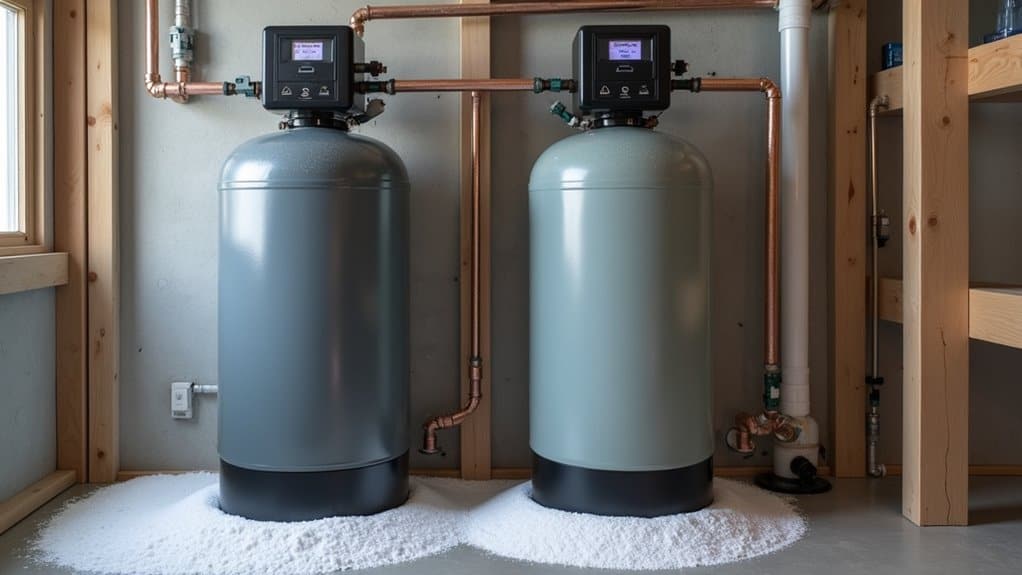Oversized water softeners waste money through higher purchase costs, excessive salt consumption, and increased water usage. We’ve found that properly sized systems regenerate every 2-3 days based on your actual water hardness and household usage (about 75 gallons per person daily). Right-sizing your softener prevents bacterial growth from stagnation while extending appliance lifespans and reducing environmental impact. Calculating your specific grain capacity needs ensures optimal efficiency and performance throughout your system’s operational life.
Key Takeaways
- Oversized water softeners cost significantly more upfront and require higher ongoing expenses for salt and water.
- Proper sizing prevents bacterial growth that can occur in underutilized, stagnant areas of oversized systems.
- Calculate your exact needs by multiplying daily water usage by hardness levels to determine appropriate system capacity.
- Right-sized systems typically regenerate every 2-3 days, ensuring optimal resin efficiency and performance.
- Correctly sized water softeners reduce environmental impact through decreased salt, water, and energy consumption.
The Hidden Costs of Oversized Water Softeners
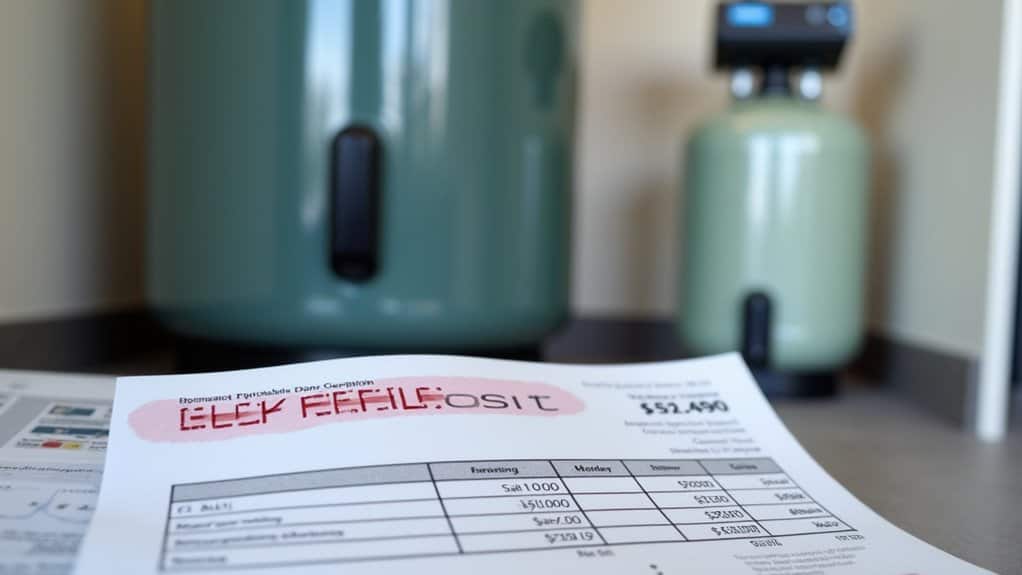
When homeowners install water softeners that exceed their actual needs, they unwittingly commit to a cascade of unnecessary expenses that extend far beyond the initial purchase price.
Oversized units command premium prices—often double that of appropriately sized systems—while demanding more complex plumbing configurations. This increased cost is compounded by the fact that improperly sized systems can lead to significant cost savings if the right size is chosen from the start.
The financial drain continues through higher salt consumption, increased water bills from excessive backwashing, and potential permit fees for larger installations.
These systems create a troubling cycle: excessive regeneration wastes resources, while underutilization leads to channeling and bacterial growth. The stagnant water common in oversized units creates ideal conditions for harmful bacteria growth.
The irony? You’ll pay more upfront for a system that delivers shorter lifespans, higher maintenance costs, and decreased efficiency.
Understanding Your Home’s Actual Softening Needs
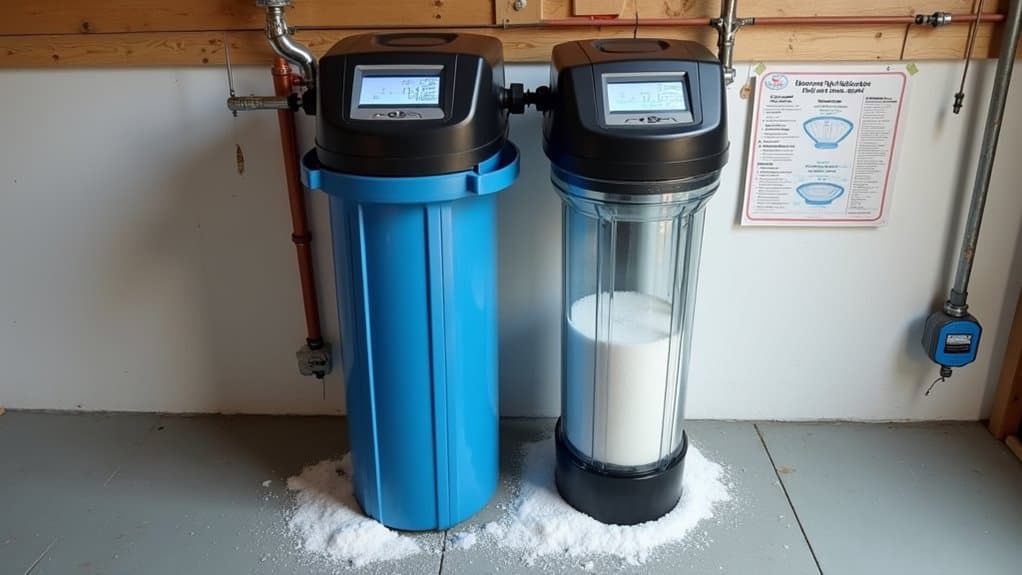
How do you determine exactly what your household requires from a water softener? It’s about calculating your specific needs rather than accepting oversized recommendations.
| Factor | Calculation | Example |
|---|---|---|
| Water Hardness | Test or city report (GPG) | 10 GPG (very hard) |
| Daily Usage | People × 75 gallons | 4 people = 300 gal/day |
| Grain Load | Usage × Hardness | 300 × 10 = 3,000 grains/day |
| System Capacity | 7-day capacity needs | 21,000 grains minimum |
We recommend matching system capacity to your actual demand. A properly sized unit regenerates weekly, using less salt and water while maintaining optimal efficiency. This ensures optimal performance and reduces the likelihood of wasted energy and unnecessary maintenance costs over time. Selecting an oversized system can lead to wasted energy and unnecessary maintenance costs over time.
Finding the Sweet Spot: Optimal Regeneration Cycles
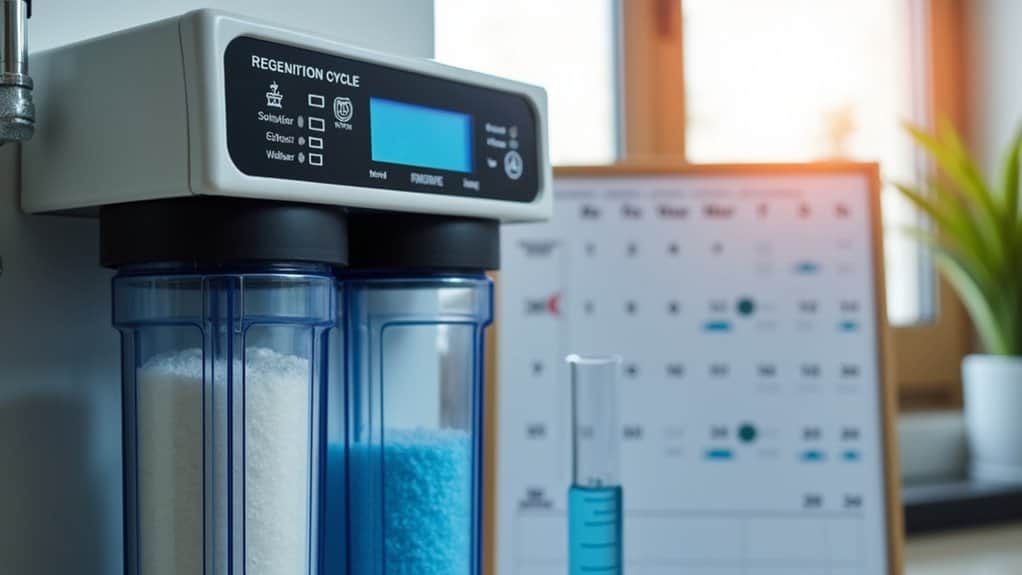
Determining the optimal regeneration cycle for your water softener represents a crucial balance between performance and efficiency.
Most systems regenerate every 2-3 days, but several factors influence ideal frequency.
Water hardness levels directly impact regeneration needs—higher mineral content saturates resin faster. Additionally, water softener sizing should take into account variations in water use and hardness to ensure optimal performance.
Household size and usage patterns significantly affect cycle timing, as do tank capacity and control valve type.
An appropriately sized system will optimize ion exchange efficiency without wasting resources.
Modern demand-initiated systems regenerate based on actual usage rather than arbitrary schedules.
We recommend considering dual-tank systems for continuous soft water or high-capacity resin for extended cycles.
Remember that excessive regeneration wastes salt and water, while insufficient cycling leads to hard water breakthrough.
Long-Term Benefits of Properly Sized Systems
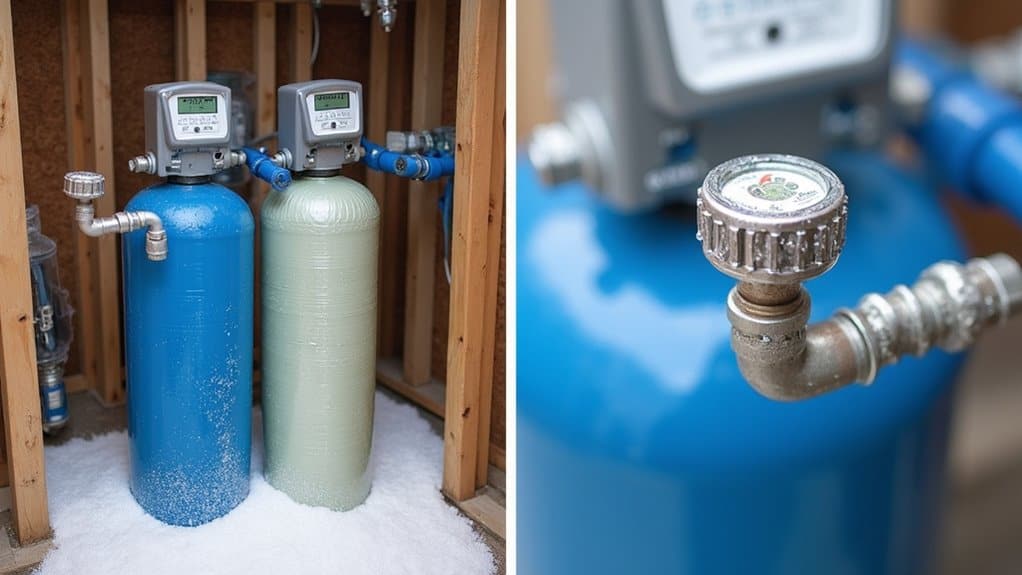
Investing in a properly sized water softener delivers substantial long-term benefits that extend well beyond initial installation considerations.
When dimensioned correctly, these systems optimize resource utilization while maximizing performance throughout their operational lifespan. One common costly mistake to avoid is selecting a unit that does not match your household’s specific water usage needs.
Key advantages include:
- Significant cost savings through reduced salt consumption, minimized water waste, and decreased energy usage
- Extended appliance longevity by preventing scale buildup in pipes, fixtures, and water heaters
- Environmental protection via reduced brine discharge and smaller carbon footprint
- Optimized system durability through balanced regeneration cycles that prevent resin damage and media degradation
Consistent water quality is maintained when the softener capacity aligns with household usage, eliminating the water quality fluctuations common in oversized systems.
These benefits compound annually, making proper sizing a crucial decision for sustainable water treatment.
Frequently Asked Questions
Can I Mix Different Types of Salt in My Water Softener?
We don’t recommend mixing salt types in your water softener. Different dissolution rates can cause salt bridging, inconsistent softening, and increased maintenance requirements. Stick with one type for optimal performance.
How Does Water Temperature Affect Water Softener Performance?
We find water temperature significantly impacts softener performance. Cold water slows ion exchange efficiency while warmth increases capacity but risks leakage. Temperature fluctuations affect resin integrity, backwash rates, and regeneration effectiveness.
Should I Soften My Outdoor Irrigation Water?
We don’t recommend softening irrigation water. It introduces harmful sodium to soil, depletes essential plant nutrients, and causes salt accumulation. Instead, install bypass systems or collect rainwater for healthier garden irrigation.
Do Water Softeners Remove Beneficial Minerals From Drinking Water?
Yes, we do remove calcium and magnesium during softening. While these minerals offer nutritional benefits, they’re typically acquired through diet rather than drinking water’s minimal contribution to daily intake.
How Do Power Outages Impact My Water Softener’s Programming?
We’ll need to reset your softener’s clock after outages exceed 24 hours—time settings affect regeneration cycles. While configuration and resin saturation remain intact, your system’s effectiveness depends on proper timing recalibration.
Conclusion
We’ve explored why choosing the right-sized water softener is critical for operational efficiency. Oversized units waste salt, water, and energy through unnecessary regeneration cycles. By calculating your household’s actual hardness demands and consumption patterns, you’ll identify the optimal system capacity. A properly sized softener delivers consistent water quality while maintaining ideal regeneration frequency. This balanced approach maximizes efficiency, extends equipment lifespan, and reduces environmental impact—proving that precise sizing trumps the “bigger is better” misconception.

Craig “The Water Guy” Phillips is the founder of Quality Water Treatment (QWT) and creator of SoftPro Water Systems.
With over 30 years of experience, Craig has transformed the water treatment industry through his commitment to honest solutions, innovative technology, and customer education.
Known for rejecting high-pressure sales tactics in favor of a consultative approach, Craig leads a family-owned business that serves thousands of households nationwide.
Craig continues to drive innovation in water treatment while maintaining his mission of “transforming water for the betterment of humanity” through transparent pricing, comprehensive customer support, and genuine expertise.
When not developing new water treatment solutions, Craig creates educational content to help homeowners make informed decisions about their water quality.


